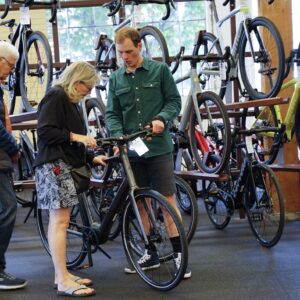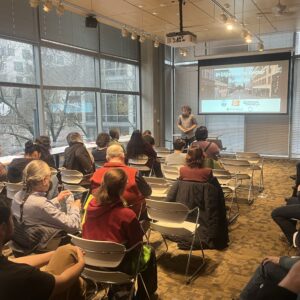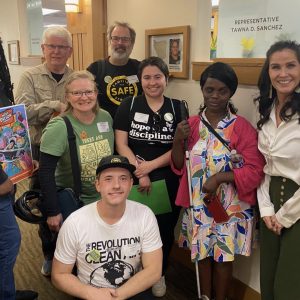(Author’s note: This article is the second part in a three-part series from The Street Trust, the Portland-based nonprofit fighting to win $161 million for safe streets, transit operations, and clean air in the 2017 Oregon legislative session. See part one here)

(PDF)
Oregon is in the best position to pass policy improvements and transportation funding in the 2017 legislative session, since the highway-heavy Jobs and Transportation Act of 2009. This is our chance to win $161 million in funding for safe streets.
The Street Trust is part of Transportation for Oregon, a coalition of progressive partners including Oregon Environmental Council, OPAL Environmental Justice Oregon, 1000 Friends of Oregon, Transportation for America, Better Eugene-Springfield Transit, the Oregon Conservation Network, as well as many others who are focused on winning the following key priorities in this session’s forthcoming transportation package:
Goal: A new state and/or local revenue source for transit needs.
Currently, transit providers across the state are unable to keep up with increased ridership, the needs of youth, the needs of older adults, and the needs of people with disabilities. Oregon contributes proportionately much less funding to transit than most other states—only 3% of operations funding, compared with state contributions of over 24% nationally. We’re asking the legislature to provide state funding to match and leverage local, regional and federal funds; to invest in more transit service (a lifeline in rural communities and key growth strategy in cities and suburbs).
Goal: Launch a statewide youth transit program to fund transit passes and improve transit service that expands youth access to schools, jobs and other opportunities.
Due to limited transportation options, some students are chronically late or absent, fall behind, and simply drop out of school altogether. We’re asking the legislature to help youth succeed, by providing free or reduced-price transit passes to youth and improving transit service to meet youth’s transportation needs, including access to broader opportunities (after-school activities, tutoring and jobs).
Goal: Achieve zero serious traffic and work zone injuries and fatalities in Oregon by 2035; establish a broad task force to help build consensus around shared safety goals focusing on policy, roadway improvements, outreach and enforcement
The number of pedestrians, bicyclists, and motorists killed on Oregon roadways each year has increased the last two consecutive years. During that time period, 973 people have died on our streets (492 in 2016 and 445 in 2015). To achieve zero deaths or serious injuries, our transportation system must be easy to navigate and safe for all ages and physical abilities, while providing safe transportation options. Improving roadway design, speeds, enforcement, behaviors, technology, and policies will make our roads and streets safer for all users.
Goal: Expand the Safe Routes to School program to build safe places to walk, bike, and access transit to school, prioritizing Title 1 schools where a majority of students are eligible for free and reduced lunch.
Kids who can safely walk and bike to their neighborhood school get regular physical activity and perform better in school, but far too many Oregon communities lack safe sidewalks, bikeways and crosswalks. Comprehensive Safe Routes to School programs (including safety education and street safety improvements near schools) are very effective, increasing walking and biking to school by 40%. Keep an eye out for our April legislative update, which will include a deep dive into the Safe Routes to School For Every Kid Campaign.
Advertisement
Goal: Identify new revenues for biking and walking safety projects, inside and outside the highway right of way.
Better bicycle and pedestrian infrastructure provides critical and affordable connections, while improving community health and well-being. As Oregon’s population grows—putting greater demands on the transportation system—giving more people the choice to walk or bike will be critical to reducing congestion. Additionally, the state’s economy benefits from people who travel by foot or by bike to visit Oregon’s scenic beauty and tourist destinations; bicycle tourism brings millions spent annually in local communities. We’re asking the legislature to dedicate increased revenue toward making bicycling and walking infrastructure safe and plentiful.
Goal: Increase state funding for planning and projects that achieve greenhouse gas emissions reduction goals.
Transportation is the single largest source of climate-changing greenhouse gases (GHGs) in Oregon. Recognizing this, the legislature provided the state’s major urban areas with the authority and planning tools to create land use and transportation plans that result in less climate pollution over time. Each major urban area now has a transportation-related GHG reduction target, but only the Portland metro area is required to meet its target. Oregon’s Department of Land Conservation and Development (DLCD) and Department of Transportation (ODOT) have provided technical assistance to other urban areas around the state that recognize the many co-benefits of this type of planning (e.g., better health, lower household transportation costs, and less expensive infrastructure). We’re asking the legislature for a small infusion of funding to enable DLCD and ODOT to provide continued technical assistance.
Goal: Support the purchase of zero emission electric vehicles.
Electric vehicles are inexpensive to operate and maintain: several models can be leased for less than $200 per month. However, upfront costs can still be a barrier. A rebate of up to $2,500 will help cover the cost of a down payment, expanding the market and helping Oregon clean up its air and keep more fuel spending circulating in the local economy. Additionally, we’re asking the legislature to provide rebates to help transit districts cover the upfront costs of clean electric buses and pilot ways to ensure that low- income families benefit from clean electric transportation.
Goal: Ensure Oregon Department of Transportation (ODOT) management structure and spending decisions are transparent and accountable to Oregonians.
The public has low confidence that the state is investing in the most cost-effective transportation projects or those that will yield the greatest benefits in communities across the state. ODOT has the opportunity to rebuild trust in two ways. First, it will adapt its management based on recommendations from a current audit of agency. Second, by creating a consistent, objective scoring process reflecting Oregon’s values to evaluate projects and clearly communicating that process online, ODOT can help the public more clearly see how decisions are made.
Goal: In order to maximize accountability, transparency, and return on investment, utilize principles from project prioritization, least cost planning and practical design.
ODOT’s transportation investment decisions are largely stakeholder-driven, with inconsistent application of techniques that maximize return on investment, reducing taxpayers’ confidence that they are getting the most for their tax dollar. Three strategies work in tandem to maximize accountability, transparency and return on investment:
1. By creating a new, objective scoring process to evaluate projects, the Oregon Transportation Commission will be able to pick projects that have a strong return-on-investment, and legislators and taxpayers will have a clear way to see the results from spending on transportation projects.
2. Least cost planning applied to priority corridors around Oregon will allow stakeholders to apply their values to come up with groups of projects that work together to solve challenges on each corridor.
3. Giving ODOT greater flexibility to design projects and tasking the agency to reduce project costs (i.e., practical design) will allow for more cost-effective designs that can still increase safety and access but at a lower cost and more appropriate scale.
As a coalition we’ve been working with legislators and people across the state to ensure that we have the support we need to win at least $161 million worth of annual funding for these priorities. By focusing the transportation funding package on a broad array of safety improvements, bicycle and pedestrian investments, and environmental safeguards, we can create a more balanced transportation system that offers Oregonians more choices for how we get around.
Here’s how you can help:
Contact your legislators. Have conversations around the importance of investing in new transit, safety, safe routes, and bicycle and pedestrian infrastructure. In the coming months, follow up your conversations with legislators to remind them how important our ask is, and attend hearings (currently scheduled on Mondays and Wednesdays, 5:30 to 7:30 p.m.) at the Capitol in Salem.
Deliver testimony. Share your personal story about why you want safe streets; convince the Legislature to invest.
Sign up and stay informed. Receive action alerts from The Street Trust, throughout the legislative
session. This is one of the best ways to stay involved in the process; our coalition partners will be pushing for your support as well. For more information on Transportation for Oregon’s future, check out our coalition’s website.
— Gerik Kransky, Policy Director, The Street Trust
BikePortland is supported by the community (that means you!). Please become a subscriber or make a donation today.







Thanks for reading.
BikePortland has served this community with independent community journalism since 2005. We rely on subscriptions from readers like you to survive. Your financial support is vital in keeping this valuable resource alive and well.
Please subscribe today to strengthen and expand our work.
Nice puff piece.
I support almost all the goals here.
Who would not? I doubt no one who comments here does not support the goals mentioned.
What exactly does the “street trust” do?
I have no idea.
I ride 7000 miles a year in this city.
My commute has not changed in 10 years. Northeast thru downtown to Barbur to Multnomah to Tigard.
It is basically the same on a bicycle as it was years ago. A bit of paint, not much more.
This cities bike town image is so overrated and the ‘street trust” or BTA or whatever has done not that much in all the years it has been around.
The number of bike commuters has gone up but seems to have leveled out in the last couple of years. It takes effort to bike commute. I am not sure the general public really has what that takes….
Please do not lobby the government to pay me $2,500 to acquire a vehicle, even a zero-emissions one.
Keep it up with all this other stuff, though! Thanks.
How about being lobbied to buy a bike, as a ‘zero emissions vehicle’?
Today, there are lots of new bikes that cost as much as a working used car.
A married couple I’m friends with, have been driving around an old toyota for two years or so…paid a thousand dollars. I tried to talk them into biking or walking, at least for some of their routine nearby trips. Maybe they feel they’re too old to be doing much walking…don’t know. I think they’re too afraid of traffic to ride a bike in it.
All the street trust’s goals named in this guest article, have good enough points included, even if the chances of achieving some of them seem to me like longshots at best. For most people, I think constructive goals could be stated much more simply.
In my area, Central Beaverton, I like to think what many people would really like, is for their central city to easier and more pleasant to get around in without having to drive for every single travel need they need to meet. And…the city seems to understand this, and actively pursues the development of plans, and building out of projects, to have the city be exactly that.
Big problem: the process is very slow, literally years for relatively simple active transportation projects to proceed from idea to physical existence(check out the latest beaverton city newsletter for examples.). If that process could somehow be sped up, that might be a very positive thing. More people might actually start walking, instead of driving…if their streets were actually nice to walk along. And if riding on the city’s streets wasn’t so often like some kind of weird carnival funhouse ride that’s far more scary than it is fun.
Embrace of streets and community livability that Street Trust seems committed to, acknowledging people’s use of them with the full range of travel modes they rely on, sounds good to me. It’s the basic goal of having their streets, their neighborhoods and their local community…meaning nearby where they shop, go to school, etc…be more comfortable, safe and functional, that I’m hoping more people out here are becoming interested in working to achieve.